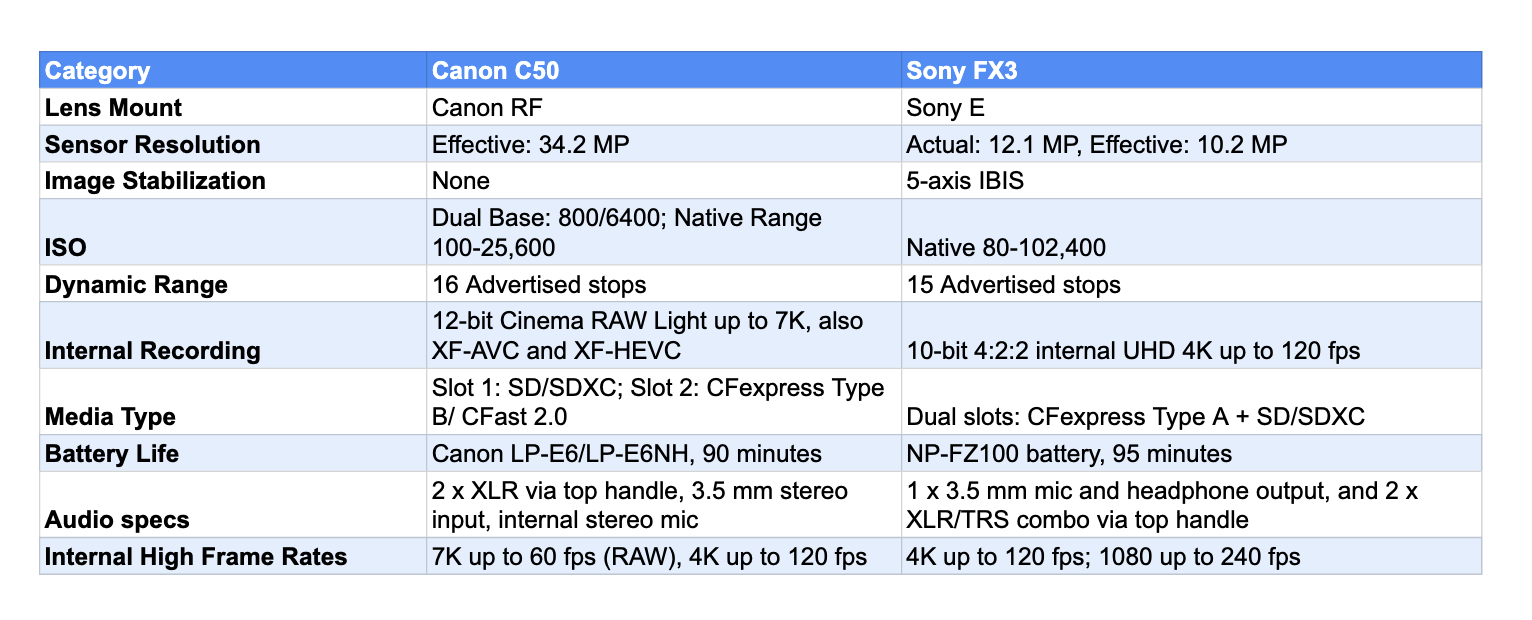Can the Canon C50 Dethrone the Sony FX3?
When deciding what cinema camera is going to be the best fit for your priorities and workflow, it's not about just one spec, but what trade-offs you’re prepared to sacrifice. Let’s see what the Canon C50 and the Sony FX3 offer.
What the Canon C50 Embodies
Price- $3,899.00
Exemplary Color Science & Skin Tones
One of the many traditional strengths of Canon cameras is their remarkable work in color rendering, especially with skin tones. Its natural, smooth highlights, and simpler out-of-camera color rendering helps create realistic pigmentation. The FX3 has the tendency to make highlighted areas shift in color, even with the appropriate exposure, making warm tones appear with a more unnatural look. Its roll-off into highlights can feel abnormal and harsh, and the work for correcting this issue can be time consuming. Because of Canon’s renowned color science, images taken on the C50 need minimal grading. The C50 also handles subtle shifts in complexion with profound distinction, making it the practical choice.
Less Sacrifice & Adaptability to Owners of Canon Glass
If you already have Canon’s RF or EF lenses, there is capability to reuse them with minimal hassle, since the C50 uses Canon’s RF mount natively. You can also adapt EF glass to a new canon easily and relatively cheaply, instead of purchasing a new lens. The auto focus function works well with adapted lenses, as long as you maintain an EF-to-RF adaptor. Canon also maintains backwards compatibility to lower the cost of moving to the C50.
7K Internal RAW & Open Gate
One of the biggest differentiators is the C50 uses internal 12- bit Cinema RAW Light, up to 7k 60fps, and an “Open Gate” mode to extend the full uses of that sensor. This provides massive flexibility for reframing and other editing tools in post.
Still-Shooting Hybrid
The C50 not only offers impressive video qualities, but also functions with strong still features. It can capture 32 MP photos, burst rates of around 40 fps, and RAW captures. Compare it to the Sony FX3, which only holds 10 MP, guaranteeing the C50 captures three times better resolution in its images. Therefore, if you want a camera that can still hold its own in photography, Canon is the superior choice.
Where the Sony FX3 Holds the Edge
Price: $4,298.00
FX Workflow Adaptation & Establishment
Sony’s FX line is currently heavily adopted in numerous professional environments and workflows. The Sony FX ecosystem is designed to incorporate new Sony technologies. The FX6 and FX9 cameras were formulated to adapt well with other Sony FX cameras to ensure a smooth transition into the workplace. Purchasing a FX3 can also be beneficial for freelancing and could mean more work opportunities, considering how widely the Sony FX line has been adopted into the commercial and broader content world.
In-Body Image Stabilization (IBIS)
The Canon C50 does not have IBIS, meaning external rigs, gimbals, or other means of stabilization are needed. However, the FX3 has a 5-axis IBIS and embedded Active Mode, which provides stability for handheld and run-and-gun shots.
Low Light Performance Superior
The FX3 has a higher ISO flexibility for extreme low light situations and better noise performance. It has also been tested in less than ideal conditions and performed very well, giving it the edge. While the C50, which has dual base ISO, provides low-light capability better than previous Canon cameras, the FX3 is still favored.
Internal High Frame Rates
When it comes to high frame rate capacity, The FX3 is the clear choice. It can record UHD 4K at up to 120 fps in 10-bit 4:2:2, permitting filmmakers to capture detailed, smooth footage. When set to 1080p, it can progress to a further 240 fps, which is ideal for slow motion or extreme action. The FX3 offers greater flexibility across resolutions, making it the stronger choice.
Comparison of the Canon C50 vs. Sony FX3
Final Thoughts
While the Canon C50 continues to follow in the footsteps of the renowned Canon camera line, it does not dethrone the Sony FX3. Both cameras have exceptional qualities and abilities and the decision between the two relies on what the filmmaker is trying to accomplish. The FX3 still leads in low light function and autofocus reliability, but nothing can beat Canon’s color science and grading. Its trusted color system enhances natural skin tones without the need for heavy post-production editing. For filmmakers who value natural, organic color and cohesiveness, the C50 is a compelling choice.



